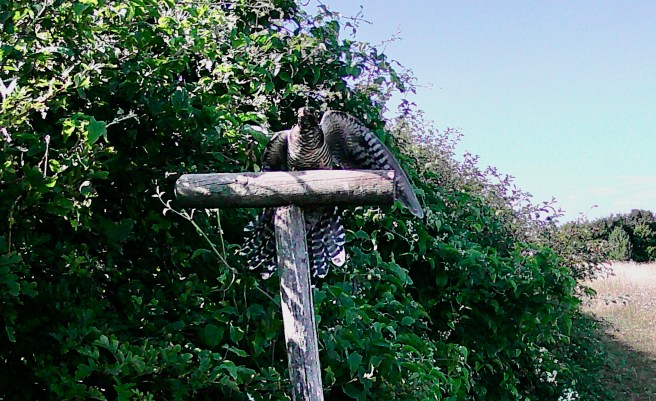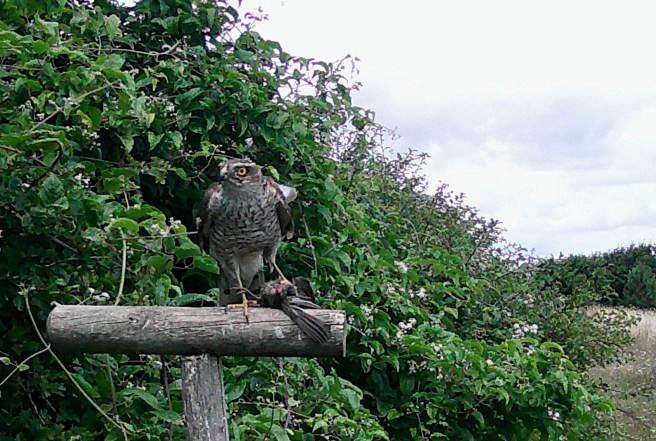The autumn migration is always an exciting time here as birds converge from around the country awaiting good conditions to cross the sea on their way south. This year the season got off to a thumping start when a new bird species for the meadows, the cuckoo, stopped by briefly en route to the Congo Basin in central Africa.

In the UK, we have lost a disquieting 40% of our cuckoos in the last twenty years and the British Trust for Ornithology has been satellite tracking them on their migration for over a decade to try to find out why. Much has already been discovered about the routes they take, some of which are more successful than others, and their important stop-off points along the way, which can hopefully be protected now that their importance is known.
The cuckoo that landed on a perch in the meadows this week will have been born this year, most probably in the nest of a Reed Warbler, Dunnock or Meadow Pipit. It will never have met its true parents, who will have left to return to Africa back in June once the eggs were laid.
After this cuckoo hatched out of its egg, it will have pushed all its hosts’ eggs or chicks out of the nest so that it alone received the food being brought in by its adoptive parents. By the time it fledged, it will have been much bigger than them but they will still have continued to loyally feed it for another couple of weeks whilst it found its feet.

Several weeks after its true parents departed for Africa, the young cuckoo was then ready to start its own journey south to follow them. When it fleetingly touched down in the meadows this week, its solo journey to The Congo had only just begun and there is no one to show it the way – it is all really rather incredible and I wish it the best possible luck on its perilous journey south.
There have been lots of birds sitting on that same perch this week. Here is an atmospheric photo of the wonderful starlings:

I think this is a crow sitting on the camera rather than the perch..

…but there is a bird on the perch behind it – and why is the crow still there?

The crow obviously feels, because of its size, that it is safe from sparrowhawks.

This smaller bird, though, was not so fortunate:


The kestrel has also been seen on the same perch as well as several other places this week, hunting for rodents.






But it is a magpie rather than a kestrel that has been photographed with a rodent hanging out of its beak:

Magpies and crows are also plucking heads of grain from the crop growing in the neighbouring farmer’s field.

This next photo looks like time lapse photography, but is in fact three magpies, the top one doing a loop the loop.

This house sparrow photo also looks a bit like time lapse, I thought:

Like the kestrel, the weasel’s primary food source is mice and voles and its small, long body allows it to follow the rodents into their underground burrows:

There have been several yellowhammers singing along the hedgerows this summer and it is now lovely to see these three juveniles as an indication that things have gone well for them.

Droughts such as we are experiencing this summer are very difficult for animals that would ordinarily eat worms as a significant part of their diet, such as badgers. Devastatingly, all three of this year’s badger cubs perished once they had been weaned, unable to get worms out of the hard ground. The adults themselves are having to find alternative food sources where they can.

We had noticed a Common Wasp nest in the chalk bank a week or two ago. Now, the badgers have also seen – or rather smelt – it and have dug it out to get at the juicy larvae. They must get badly stung while they do this but it doesn’t seem to stop them.


In the wood, the marjoram glade has come into its full glory and is dancing with bees and butterflies:






I travel up to Maidenhead every fortnight to see my father and, whilst there, always try to visit the Spade Oak gravel pit in Little Marlow. It is good place to spot birds and, fantastically, has recently become a nature reserve.

This year there are two pairs of breeding great crested grebes but one of these pairs has been beset with problems. Last week its eggs were predated for a second time.

There is always something of interest to see when we visit the reserve – but this time we were in for a particular treat. It seems that the pair of grebes have sufficient stamina to start egg laying once again and were displaying to each other and performing their courtship ritual, the famous weed dance. They both dived down and resurfaced carrying weed in their beaks. They then advanced towards each other with their neck feathers puffed up.


It was a wonder to behold and I hope it will be third time lucky for them with this fresh breeding attempt. We will be watching their progress with great interest on future visits.
Our son and his girlfriend are still in Sri Lanka as they continue their world tour.




Sri Lanka has been much in the news recently but they have found the country calmer than might be expected on reading the reports in the British press. Their time there, though, is nearly up and they are off to the Maldives this weekend.

The perch is such a great way of seeing your birds. Fantastic that you have had a cuckoo visit. Never seen one or even heard one in Clitheroe for a long time. Luckily do hear them up here in Cumbria, where I am at the moment. Hope the grebes at the gravel pit have more success this time around.
We have a cottage on Lake Coniston booked for a week in September – love the Lake District so much x
Oh fabulous. It’s lovely there. We used to go camping at Coniston Old Hall Campsite. They had some naughty tent eating goats though! The Steam Boat on Coniston is a good way of seeing the lake. X